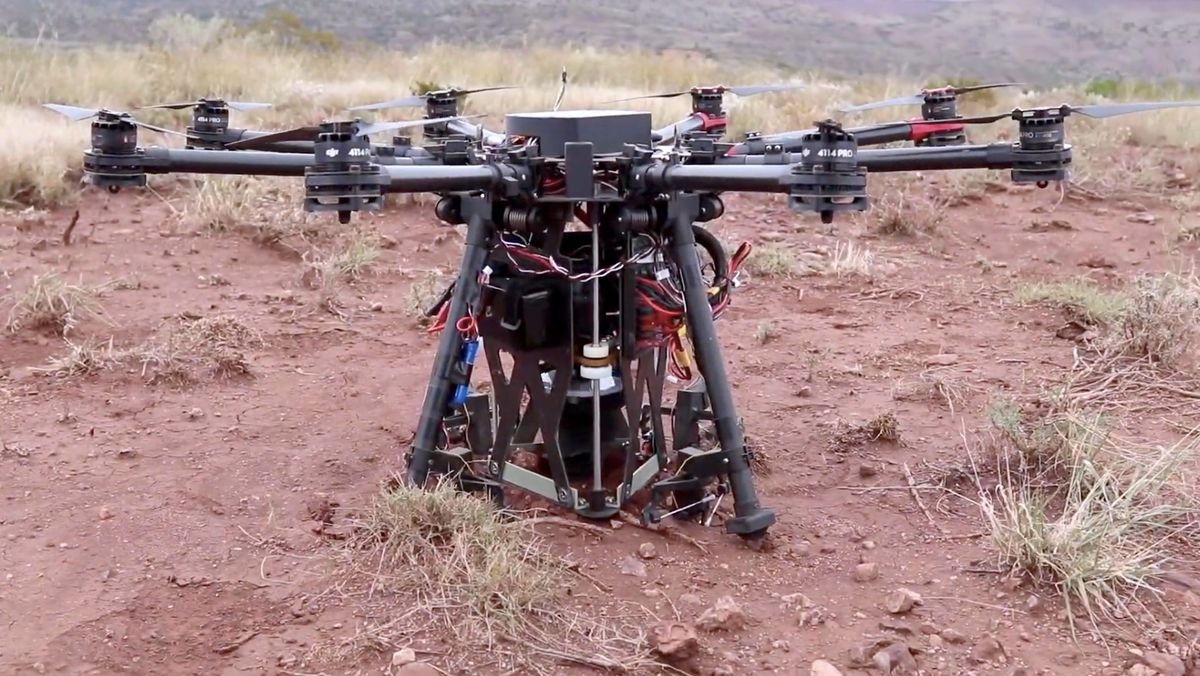The NIMBUS Lab at the University of Nebraska has been developing drones that have the unique ability to dig holes in the ground and then fill those holes with sensors. If this sounds like a complicated task, that’s because it is: The drone needs to be able to carry a portable digging system a useful distance, locate a diggable spot, land, verify that the spot it thought was diggable is in fact diggable, dig a hole and install the sensor, and then fly off again.
At IROS late last year, folks from the NIMBUS Lab presented a paper detailing a rather burly quadcopter that could carry an auger with an embedded sensor and use it to place the sensor in the ground (you can see a video of this in action here). And at ISER a few weeks later, they presented another paper on how the drone can autonomously figure out whether it’s digging in a good spot or not.
One of the biggest challenges to a system like this is that by the time you pack in the drilling rig and all the sensors and computers that the drone needs to operate autonomously, you’ll be lucky if the thing will manage to keep itself aloft for more than just a few minutes. This is not particularly useful, since the whole point is to send the drone out to place sensors in areas that you can’t easily get to yourself. What’s needed is a way of extending the drone’s range, and the NIMBUS Lab came up with one: A helicarrier, a parachute, and one of the most bizarrely effective drone deployment systems I’ve ever seen.
For more details, we spoke with the principal investigator on this project, NIMBUS Lab co-director Carrick Detweiler, via email.
IEEE Spectrum: Can you explain what we’re seeing in the video?
Carrick Detweiler: In this video a large UAS is carrying our smaller UAS in a capsule to enable long range transport. Once it reaches near the goal location, the smaller UAS drops and parachutes to a lower altitude. We use a parachute as this allows the capsule to be dropped from most any altitude. When it is low enough, the capsule releases, then the arms on the UAS extend before detaching from the parachute to fly to the goal location. We travel with the arms folded up to reduce the size of the capsule to make the whole system more aerodynamic. The [smaller] UAS is based on a heavily modified DJI S1000 using with a Pixhawk flight controller to allow autonomy. Our UAS then flies to the goal location to dig a hole in the ground to emplace a sensor.
Why use this deployment system? What makes this particular combination of two drones, a carrying container, and a parachute the best solution to accomplish your objectives?
Battery powered drones have very short flight times, especially when flying with a heavy load, which we are since we have our digging apparatus and sensor system. So to get to distant locations, we need to hitch a ride on another vehicle. This allows allows it to save energy for return trips. In this video we used a much larger gas powered UAS with multiple hours of flight time, but our same system could be deployed from manned aircraft or other systems.
How autonomous is the drone? Does it select its own site for sensor emplacement, and can it try again somewhere else if emplacement is not successful?
Our UAS performs the detachment, parachuting, etc autonomously. Currently the sensor emplacement site is manually selected, however, the system is smart enough to know if it is likely to succeed in emplacing a sensor after just a short amount of digging. If it isn’t likely to succeed, then the system can go to other nearby locations to try again.
What are some potential use cases for this system?
Our system can be used to deploy a wide range of sensors in remote or hard to access locations. We have a USDA-NIFA project where we are deploying sensors and UASs in sensitive wetlands environments, which are often hard to access in other ways without impacting the environment. We need to dig the sensors into the ground both to secure the sensors so they don’t get washed away, but also for sensors such as soil moisture sensors that need good contact below the surface.
What are the most significant challenges at this point, and what are you working on next?
Field experiments with real systems are always challenging. In this case it was particularly challenging as our system was carried over 10 miles and in weather we had not previously tested in (high winds and below freezing temperatures). This emphasized the need for greater autonomy systems that can automatically monitor to detect faults and take corrective actions in situations that the programmers may not have initially envisioned. We will be continuing to work on this system to increase the robustness to uncertain conditions.
As you might expect, wetland monitoring isn’t the only potential application for a system like this, and the NIMBUS Lab is also working under a contract from the Department of Defense. But even beyond sensor emplacement (which seems likely to be what the DoD has its eye on), it’s easy to imagine how (relatively) small drones could team up like this for range extension and payload delivery in other interesting areas, from medical supply delivery to delivering even more drones, like CICADAs or little insect-scale ground robots.
Bits of this research have been presented at recent robotics conferences, including ISER and IROS, and you can read the papers here and here.
[ NIMBUS Lab ]
Evan Ackerman is a senior editor at IEEE Spectrum. Since 2007, he has written over 6,000 articles on robotics and technology. He has a degree in Martian geology and is excellent at playing bagpipes.



